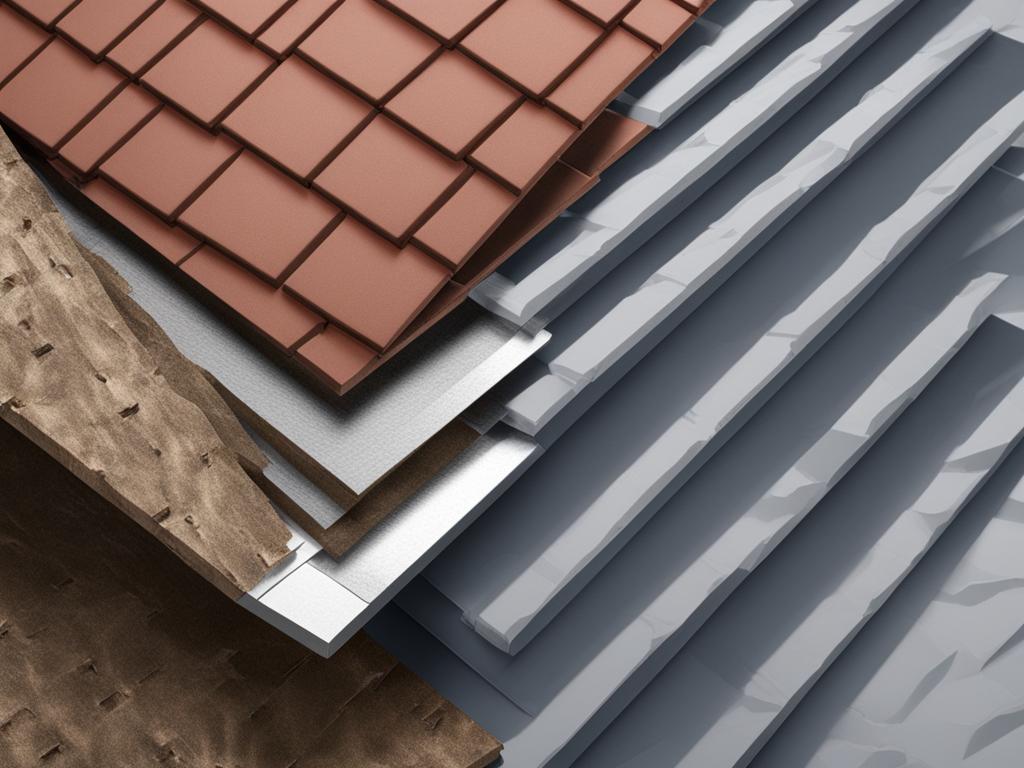Welcome to our comprehensive guide comparing polyiso and XPS insulation materials. When it comes to insulating your space, it’s important to choose the right material that meets your specific needs. In this article, we will explore the critical differences between polyiso and XPS insulation, helping you make an informed decision for your project.
Insulation plays a vital role in maintaining thermal comfort and energy efficiency. Both polyiso and XPS insulation are widely used in various applications due to their excellent insulation properties. By understanding the unique characteristics of each material, you can choose the one that best suits your needs.
Key Takeaways:
- Polyiso and XPS insulation are popular choices for their thermal performance and moisture resistance.
- Polyiso insulation has a slightly higher R-value per inch compared to XPS insulation.
- XPS insulation offers greater compressive strength and moisture resistance.
- Polyiso insulation is more cost-effective, while XPS insulation is more expensive.
- Both materials require proper installation techniques for optimal performance.
Understanding Insulation and Its Purpose
Insulation plays a crucial role in controlling the flow of heat and reducing noise transmission. Whether you’re looking to keep the heat inside during winter or prevent heat buildup in the summer, insulation is key in creating a comfortable and energy-efficient environment. Additionally, insulation helps to dampen road noise, making the interior of your van quieter and more enjoyable.
There are various types of insulation available, each serving a specific purpose. Heat insulation focuses on preventing the transfer of heat, while noise insulation aims to minimize sound transmission. A well-insulated space not only provides thermal comfort but also contributes to energy savings and improved acoustic performance.
One of the primary functions of insulation is to create a thermal barrier by reducing heat transfer through conduction, radiation, and convection. This barrier helps to maintain a stable temperature, providing a cozy atmosphere while minimizing energy consumption. Insulation materials with higher R-values offer increased resistance to heat flow, enhancing their thermal performance.
When it comes to van insulation, it’s crucial to consider the unique requirements of this mobile space. Insulating your van effectively helps combat extreme temperatures, ensuring a comfortable interior regardless of the weather conditions outside. Moreover, reliable insulation can contribute to energy efficiency by reducing the load on your HVAC system.
For a complete understanding of insulation and its purpose, let’s dive into the science of heat transfer and explore the different types of insulation available for your van conversion.
The Science of Heat Transfer
Understanding how heat is transferred is crucial in comprehending the effectiveness of insulation materials. Heat can be transferred through various mechanisms, including conduction, radiation, and convection.
Conduction
Conduction is the transfer of heat through a material by direct contact between particles. When heat is applied to one end of a solid object, such as a metal rod, the energy is transmitted from molecule to molecule, causing the other end to heat up. Insulation materials work by reducing the conduction of heat, creating a thermal barrier.
Radiation
Radiation is the transfer of heat through electromagnetic waves. This type of heat transfer does not require a medium or direct contact between objects. The most common example of radiation is the sun’s rays warming the earth. Insulation materials with high reflectivity can minimize the absorption of radiation, providing additional thermal resistance.
Convection
Convection is the transfer of heat through the movement of fluids (liquids or gases). As warm air rises, it transfers heat to surrounding cooler air. Conversely, cool air sinks, creating a continuous flow of heat transfer. Insulation materials hinder convection by trapping air in their structure, reducing heat movement.
Insulation serves as a thermal barrier, limiting the transfer of heat through conduction, radiation, and convection. By minimizing these heat transfer mechanisms, insulation helps maintain stable temperatures inside the van, reducing the need for excessive heating or cooling.
The effectiveness of insulation in resisting heat transfer through conduction is measured by its R-value. The higher the R-value, the better the insulation’s resistance to heat flow. It is essential to consider the R-value when choosing insulation materials for van conversions, as it determines the level of thermal protection provided.
| Heat Transfer Mechanism | Definition |
|---|---|
| Conduction | The transfer of heat through direct contact between particles. |
| Radiation | The transfer of heat through electromagnetic waves. |
| Convection | The transfer of heat through the movement of fluids (liquids or gases). |
Polyiso Insulation
Polyiso insulation is a synthetic material made of polyester and polypropylene strands that trap air between them. It is commonly used for its acoustic insulation properties and has a good R-value. Polyiso insulation is available in rolls, making it ideal for van applications. It can be glued in place and works well in hard-to-reach areas. The R-value of polyiso insulation is around R3 per inch, and it is cost-effective and relatively easy to install.

Pros and Cons of Polyiso Insulation
To help you make an informed decision, let’s take a closer look at the pros and cons of polyiso insulation:
| Pros | Cons |
|---|---|
| Good acoustic insulation properties | Lower R-value compared to some other insulation materials |
| Cost-effective | May not provide the highest level of moisture resistance |
| Relatively easy to install |
XPS Insulation
XPS insulation, also known as extruded polystyrene, is a type of rigid foam insulation commonly used in various construction applications. It is known for its excellent thermal performance and moisture resistance, making it a popular choice for insulating vans.
One of the key advantages of XPS insulation is its ability to provide effective thermal insulation. The R-value of XPS insulation, which measures its resistance to heat transfer, typically ranges from R5 to R7 per inch. This high R-value ensures that XPS insulation can effectively prevent heat from transferring in or out of the van, providing optimal energy efficiency.
Another benefit of XPS insulation is its moisture resistance. The closed-cell structure of XPS insulation makes it highly resistant to moisture absorption, making it suitable for areas prone to humidity or water exposure. This moisture resistance helps to prevent mold and mildew growth, ensuring a healthier and more comfortable interior environment.
XPS insulation boards are available in various thicknesses, allowing for easy customization to fit van walls and ceilings. These boards can be easily cut and shaped to ensure a precise fit and seamless installation. However, it is important to note that XPS insulation is more expensive compared to other insulation materials, such as polyiso.
Proper installation is crucial for achieving optimal performance with XPS insulation. It is important to ensure that the insulation is carefully installed without any gaps or voids, as even small gaps can compromise its effectiveness. Additionally, it is recommended to use appropriate adhesives and sealants to further enhance its performance and prevent air leakage.
Overall, XPS insulation offers excellent thermal performance and moisture resistance, making it a viable option for van insulation projects. However, its higher cost and careful installation requirements should be taken into consideration when making a decision.

Pros of XPS Insulation:
- Excellent thermal performance with high R-value
- Effective moisture resistance to prevent mold and mildew
- Customizable and easy to cut and shape
Cons of XPS Insulation:
- Higher cost compared to other insulation materials
- Requires careful installation to avoid gaps and ensure optimal performance
Comparison of Polyiso and XPS Insulation
When comparing polyiso and XPS insulation, it’s important to consider various factors such as thermal performance, moisture resistance, R-value, energy efficiency, cost, and installation. Both materials offer good thermal performance and moisture resistance, but they have some distinct differences.
Polyiso Insulation
Polyiso insulation is known for its thermal insulating properties and is commonly used in construction and insulation applications. It has a slightly higher R-value per inch compared to XPS insulation, making it more effective in preventing heat transfer. The R-value of polyiso insulation is around R3 per inch, offering excellent energy efficiency.
“Polyiso insulation provides superior thermal performance, effectively reducing heat transfer and maintaining a comfortable temperature inside the van.” – Insulation Expert
Polyiso insulation is also cost-effective, making it a popular choice for those looking for an affordable insulation solution. It is available in rolls, making it easy to install, especially in hard-to-reach areas. Proper installation techniques should be followed to ensure optimal performance.
XPS Insulation
XPS insulation, also known as extruded polystyrene, has excellent thermal performance, moisture resistance, and compressive strength. It is widely used in various applications, including van insulation. XPS insulation provides greater compressive strength compared to polyiso insulation, making it suitable for applications where the insulation may be subjected to heavy loads or potential impact.
“XPS insulation offers enhanced moisture resistance, protecting the van from potential water damage and mold growth.” – Insulation Specialist
The R-value of XPS insulation ranges from R5 to R7 per inch, providing exceptional thermal insulation. However, it is slightly more expensive than polyiso insulation. Proper installation techniques, including ensuring airtightness and avoiding gaps, are crucial to maximize its efficiency.
Comparison Table: Polyiso vs XPS Insulation
| Factors | Polyiso Insulation | XPS Insulation |
|---|---|---|
| Thermal Performance | Good | Excellent |
| Moisture Resistance | Good | Superior |
| R-value per inch | Slightly higher (around R3) | Ranges from R5 to R7 |
| Compressive Strength | Lower | Higher |
| Cost | Cost-effective | Slightly more expensive |
| Installation | Relatively easy | Requires careful installation techniques |
Consider your specific project requirements, budget, and installation method when choosing between polyiso and XPS insulation. Whether you prioritize thermal performance, moisture resistance, cost-effectiveness, or compressive strength, selecting the right insulation material will help create a comfortable and energy-efficient environment inside your van.
Conclusion
When it comes to choosing between polyiso and XPS insulation, several factors need to be considered to ensure the right fit for your thermal and moisture needs. Polyiso insulation offers a cost-effective option with a good R-value, making it an attractive choice for van insulation projects. On the other hand, XPS insulation provides higher compressive strength and better resistance to moisture.
Both insulation materials have their own advantages and considerations. Polyiso insulation is a budget-friendly option, while XPS insulation offers enhanced durability. The decision ultimately depends on your specific requirements and project constraints.
By carefully evaluating thermal performance, moisture resistance, installation method, and budget, you can make an informed decision. Whether you choose polyiso or XPS insulation, proper installation is crucial to achieve optimal insulation for your van.
FAQ
What is the purpose of insulation?
Insulation is designed to control the flow of heat and noise. It helps keep heat inside or outside a space and reduces noise transmission. In a van, insulation is important for combating heat buildup in summer and preventing heat loss in winter. It also helps dampen road noise and make the interior quieter.
How does insulation work?
Heat moves through conduction, radiation, and convection. Insulation creates a thermal barrier that reduces or eliminates the transfer of heat. It works by resisting heat transfer through conduction, radiation, and convection.
What is polyiso insulation made of?
Polyiso insulation is a synthetic material made of polyester and polypropylene strands that trap air between them. It is commonly used for its acoustic insulation properties and has a good R-value.
What is the R-value of polyiso insulation?
The R-value of polyiso insulation is around R3 per inch.
What are the advantages of polyiso insulation?
Polyiso insulation is cost-effective and relatively easy to install. It is available in rolls, making it ideal for van applications. It can be glued in place and works well in hard-to-reach areas.
What is XPS insulation?
XPS insulation, also known as extruded polystyrene, is rigid foam insulation. It provides excellent thermal performance and moisture resistance.
What is the R-value of XPS insulation?
The R-value of XPS insulation ranges from R5 to R7 per inch.
What are the advantages of XPS insulation?
XPS insulation offers higher compressive strength and moisture resistance. It can be easily cut and shaped to fit van walls and ceilings.
How do polyiso and XPS insulation compare?
Both materials offer good thermal performance and moisture resistance. Polyiso insulation has a slightly higher R-value per inch, while XPS insulation provides greater compressive strength. Polyiso insulation is more cost-effective, but XPS insulation offers better resistance to moisture.
Which insulation material should I choose for my project?
The choice between polyiso and XPS insulation will depend on your specific thermal and moisture needs for your van project. Consider factors such as thermal performance, moisture resistance, R-value, cost, and installation methods to make an informed decision.
